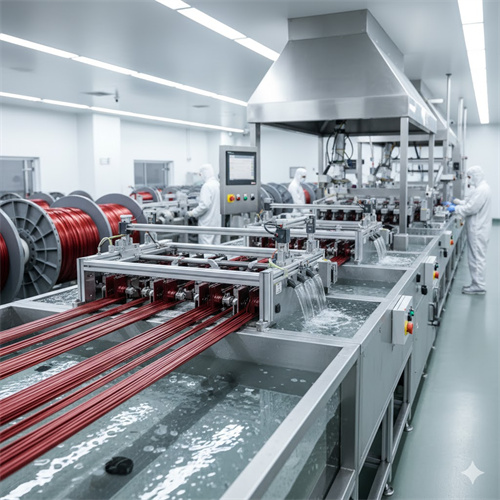Enameled wire is the heart of all electromagnetic devices (such as motors, transformers, inductors). Its insulating enamel coating is crucial, but during processes like wire processing, winding, or connection, the surface often becomes contaminated with oil, drawing compound, or paint residue from stripping.
Proper enameled wire cleaning is a critical step to ensure coil performance, prevent short circuits, and achieve reliable soldering (or crimping). Incorrect cleaning methods can not only leave contaminants but also damage the wire, affecting product lifespan.
Core Need: Why Clean Enameled Wire?
The cleaning of enameled wire primarily focuses on two core scenarios, each with different objectives:
| Cleaning Scenarios |
Core Purpose |
Common Contaminants |
Impacts and Consequences |
| After stripping wire ends |
Completely remove chemical or mechanical stripping residues |
Alkaline paint strippers, acidic residues, and carbonized paint |
Poor soldering, increased connection resistance, and wire corrosion |
| Wire surface |
Removal of oil and oxide layers from the production process |
Drawing oil, lubricant, dust, and aluminum oxide (aluminum wire) |
Poor paint film adhesion, reduced insulation performance, and uneven winding density |
This article will provide an in-depth analysis of the two most common cleaning needs for enameled wire and their corresponding practical cleaning methods.

Residual Cleaning After Wire End Stripping: Neutralization and Rinsing
Before soldering, the wire ends require the removal of the insulating paint. If chemical paint strippers (especially strong alkaline ones) are used, neutralization and secondary cleaning are key to preventing corrosion.
Initial Rinse (Remove Bulk Residue)
Method: Immerse the stripped wire end in warm clean water and agitate gently for no less than 15 seconds. Warm water effectively dissolves and washes away most of the residual stripper and loose paint particles adhering to the wire surface.
Glacial Acetic Acid Neutralization (Prevent Corrosion)
Purpose: To neutralize residues from strong alkaline paint strippers (e.g., sodium/potassium hydroxide mixtures) and prevent their continued corrosion of the wire.
Method: Immerse the wire end in a diluted glacial acetic acid solution for 10-20 seconds. This key step effectively improves subsequent cleaning and protects the exposed conductor.
Multiple Thorough Rinses (Ensure No Residue)
Method: Rinse the wire end sequentially with multiple baths of clean water, with each rinse lasting at least 10 seconds. Multiple thorough rinses are the core step to ensure all chemical neutralization products and micro-residues are removed.
Professional Cleaning Methods for Oil Contamination and Oxide Layers on Enameled Wire Surface
For cleaning the entire wire or in production processes requiring extremely high cleanliness, the following professional techniques are often used:
Ultrasonic Cleaning Method
Advantages: Fast, thorough, uniform. The "cavitation effect" generated by ultrasound in the cleaning fluid can penetrate wire gaps, effectively dislodging adhered oil and micro-particles.
Applicable Scenarios: Batch cleaning, precision coils, and situations requiring high cleanliness. Can be used with alcohol solutions or heated water with additives.
Chemical Solvent Cleaning Method
Principle: Uses organic solvents to dissolve oil contamination.
Common Solvents: Isopropyl Alcohol (IPA), toluene, etc. Can be used for wiping or immersion.
Note: Must be operated in a well-ventilated area with personal protective equipment. Some solvents may affect the insulating enamel on non-stripped sections and should be selected cautiously.
Laser Cleaning Method (High-Precision Cutting-Edge Technology)
Advantages: Non-contact, non-damaging, environmentally friendly (no consumables). Uses specific wavelength lasers to instantly vaporize or ablate contaminants.
Applicable Scenarios: When extremely high wire integrity is required, or for removing stubborn oxide layers on aluminum wire surfaces, laser cleaning offers unparalleled precision compared to traditional methods.
Key Steps After Cleaning: Thorough Drying and Proper Storage
After cleaning is complete, drying is the final step to ensure wire performance.
Wiping with Anhydrous Ethanol: For drying, it is recommended to wipe the wire with a paper towel or lint-free cloth moistened with anhydrous ethanol (pure alcohol). Alcohol evaporates quickly, effectively removing moisture and providing secondary cleaning for any residual organic matter.
Drying with Cool Air: Use clean, cool air equipment to dry the wire. Avoid using hot air to prevent wire overheating or oxidation.
Storage in a Desiccator: Cleaned wires should be stored in a desiccator or low-humidity environment to prevent re-absorption of moisture or oxidation, maintaining optimal electrical connection condition.
By mastering the enameled wire cleaning methods and steps described above, you can effectively improve product quality and ensure the reliability and service life of your coils.
